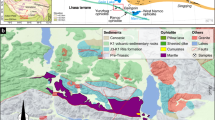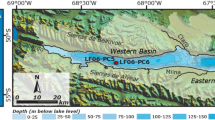Abstract
From northern Tunisia, small-scale well-preserved microbialites, contemporaneous to the global oceanic anoxic event 2 (OAE 2) are first reported on the southern Tethyan Margin. These microbialites are encased within the pelagic organic-rich black shales of the Bahloul Formation (Cenomanian–Turonian transition). Biostratigraphic, petrographic, and geochemical investigations carried out to constrain their biogenicity and genesis character led to consider them as thrombolites and stromatolites occurring in lenticular bioherms/biostromes and columnar bodies co-relatable to the global ‘filament event’ of the authors, close to the base of the Watinoceras ammonite zone. Abundant clotted micrite, cyanobacterial filaments, and algal tissues point to the key process of microbial carbonate precipitation and to a major role played by microbes in the stabilisation and subsequent lithification, which in turn favoured the preservation of the original structure of the microbialites. These microbially induced carbonate formations are considered as favoured by chemosynthetic fauna of bivalve molluscs and lithistid sponges which were able to host symbiotic microbial communities. The latter contributed to the precipitation of authigenic calcite and non-carbonate minerals (e.g. pyrite) fuelled by microbial activity under sulphate-reducing conditions. The carbonate body onset is considered to be initiated by seafloor instability due to syndepositional fault acting that induced the appraisal of uplifted tilted blocks within oxygenated waters but near the anoxic water masses. Generated depressions allowed the development of chemosynthetic-based communities. Deep faults related to Triassic salt domes acted as conducts for hydrocarbon and salt brine expulsion to the seafloor and the microbialite growth was enhanced by an abrupt uprising sea level under warmer conditions.










Similar content being viewed by others
References
Arthur MA, Schlanger SO, Jenkyns HC (1987) The Cenomanian–Turonian oceanic event II. Paleoceanographic controls on organic matter production and preservation. In: Brooks J, Fleet AJ (Eds), Marine and Petroleum Source Rocks. Geol Soc Lond Special Publ 26:401–420
Barrett P (1998) A comparative organic geochemical and stable isotope study of the Cenomanian–Turonian organic-rich sediments from Tunisia, Germany and the UK. PhD thesis, University of Newcastle, pp. 1–250
Barron EJ, Washington WM (1985) Warm Cretaceous climates: high atmospheric CO2 as a plausible mechanism. In: Sundquist ET, Broeker WS (eds) The carbon cycle and atmospheric CO2: natural variations Archaean to present. American Geophysical Union Monograph, Washington, DC, pp 546–553
Beauchamp B, Savard M (1992) Cretaceous chemosynthetic carbonate mounds in the Canadian Arctic. Palaios 7:434–450
Bechtel A, Pevaz M, Püttmann W (1998) Role of organic matter and sulphate-reducing bacteria for metal sulphide precipitation in the Bahloul Formation at the Bou Grine Zn/Pb deposit (Tunisia). Chem Geol 144:1–21
Belka Z (1998) Early Devonian Kess–Kess carbonate mud mounds of the eastern Anti-Atlas (Morocco), and their relation to submarine hydrothermal venting. J Sediment Res 68:368–377
Ben Ayed N, Viguier C (1981) Interprétation structurale de la Tunisie atlasique. CRAS, Paris, t 292, série II, pp. 1445–1448
Bice KL, Norris RD (2002) Possible atmospheric CO2 extremes of the middle Cretaceous (Late Albian-Turonian). Paleoceanography 17:1–17
Bishop WF (1988) Petroleum geology of East-Central Tunisia. AAPG Bull 72(9):1033–1058
Boltenhagen C (1981) Paléogéographie du Crétacé moyen de la Tunisie centrale. Congrès des Sciences de la Terre, Tunis, pp 97–114
Bralower TJ, Fullagar PD, Paull CK, Dwyer GS, Leckie RM (1997) Mid-Cretaceous strontium-isotope stratigraphy of deep-sea sections. GSA Bull 109:1421–1442
Burollet PF (1956) Contribution à l’étude stratigraphique de la Tunisie centrale. Ann Min Géol 18:1–350
Campbell KA, Farmer JD, Des Marais D (2002) Ancient hydrocarbon seeps from the Mesozoic convergent margin of California: carbonate geochemistry, fluids and palaeoenvironments. Geofluids 2:63–94
Caron M, Dall’Agnolo S, Accarie H, Barrera E, Kauffman EG, Amedro F, Robaszynski F (2006) High-resolution stratigraphy of the Cenomanian–Turonian boundary interval at Pueblo (USA) and wadi Bahloul (Tunisia): stable isotope and bio-events correlation. Geobios 39:171–200
Cavalazzi B, Barbieri R, Orig G (2007) Chemosynthetic microbialites in the Devonian carbonate mounds of Hamar Laghdad (Anti-Atlas, Morocco). Sediment Geol 200:73–88
Erbacher J, Thurow J, Littke R (1996) Evolution patterns of radiolaria and organic matter variations: a new approach to identify sea-level changes in mid-Cretaceous pelagic environments. Geology 24:499–502
Espitalié J, Deroo G, Marquis F (1986) La pyrolyse Rock-Eval et ses applications: Troisième partie. Rev Inst Fr Pét 41:73–89
Farrimond P, Eglinton G, Brassell SC, Jenkyns HC (1990) The Cenomanian/Turonian anoxic event in Europe: an organic geochemical study. Mar Pet Geol 7:75–89
Guirand R, Maurin JC (1991) Le rifting en Afrique au Crétacé inférieur: synthèse structurale, mise en évidence de deux étapes dans la genèse des bassins, relations avec les ouvertures océaniques péri-africaines. Bull Soc Géol Fr 162:811–823
Han X, Suess E, Sahling H, Wallman K (2004) Fluid venting activity on the Costa Rica margin: new results from authigenic carbonates. Int J Earth Sci 93:596–611
Hemadi H (1987) Les silicates et carbonates authigènes des diapirs du Nord de la Tunisie, signification chimique et thermique. Thèse de Doctorat, Université de Paris Sud Orsay, 182 p
Hoefs J (1980) Stable isotope geochemistry, 2nd edn. Springer, Berlin, 208 pp
Jati M, Grosheny D, Ferry S, Gauthier-Lafaye F, El Kamali N (2003) Enregistrement biologique, géochimique et séquentiel de la crise cénomano-turonienne sur la marge atlantique (Aghadir, Maroc). WWW.asf.epoc.u-bordeau1.fr/congres_2003/posters/Jati.pdf
Jones C, Jenkyns HC (2001) Seawater strontium isotopes, oceanic anoxic events, and seafloor hydrothermal activity in the Jurassic and Cretaceous. Am J Sci 301:112–149
Kiel S, Peckmann J (2007) Chemosymbiotic bivalves and stable carbon isotopes indicate hydrocarbon seepage at four unusual Cenozoic fossil localities. Lethaia 40:345–357
Layeb M (1990) Etude géologique, géochimique et minéralogique, régionale, des faciès riches en matière organique de la Formation Bahloul d’âge Cénomano-Turonien dans le domaine de la Tunisie Nord-Centrale. Ph.D. thesis, Univ. de Tunis II, pp. 1–209
Layeb M, Belayouni H (1989) La formation Bahloul au Centre et au Nord de la Tunisie: un exemple de bonne roche mère de pétrole à fort intérêt pétrolier. Actes des 2èmes journées de géologie tunisienne appliquée à la recherche des hydrocarbures. Mém ETAP 3:489–503
Layeb M, Belayouni H (1999) Paléogéographie de la Formation Bahloul (passage Cénomanien-Turonien). Ann Min Géol 40:21–44
Layeb M, Ben Fadhel M, Ben Youssef M (2012) Thrombolitic and coral buildups in the Upper Albian of the Fahdene basin (North Tunisia): stratigraphy, sedimentology and genesis. Bull Soc Géol Fr t 183 n° 3:217–231
Lüning S, Kolonic S, Belhadj EM, Belhadj Z, Cota L, Bariæ G, Wagner T (2004) Integrated depositional model for the Cenomanian–Turonian organic-rich strata in North Africa. Earth Sci Rev 64:51–117
Martinez C, Truillet R (1987) Evolution structurale et paléogéographie de la Tunisie. Ment Soc Geol It 38:35–45, 4 ff
Montacer M, Disnar JR, Orgeval JJ, Trichet J (1988) Relationship between Zn–Pb ore and oil accumulation processes: example of the Bou Grine deposit, Tunisia. Org Geochem 13:423–431
Negra MH, Zagrarni MF, Hanini A, Strasser A (2011) The filament event near the Cenomanian–Turonian boundary in Tunisia: filament origin and environmental signification. Bull Soc Géol Fr t 182(6):507–519
Neuweiler F, Bourque PA, Boulvain F (2001) Why is stromatactis so rare in Mesozoic carbonate mud mounds? Terra Nova 13:338–346
Orgeval JJ (1994) Peridiapiric metal concentration: example of the Bou Grine deposit (Tunisian Atlas). In: Fontboté L, Boni M (eds) Sediment-hosted Zn–Pb Ores. Society of Geology Applied to Mineral Deposits, Special Publication, vol. 10, pp. 354–388
Patriat M, Ellouz N, Dey Z, Gaulier JM, Ben Kilani H (2003) The Hammamet, Gabes and Chotts basins (Tunisia): a review of the subsidence history. Sediment Geol 156:241–262
Peckmann J, Thiel V (2004) Carbon cycling at ancient methane-seeps. Chem Geol 205:443–467
Peckmann J, Walliser OH, Riegel W, Reitner J (1999) Signatures of hydrocarbon venting in a Middle Devonian carbonate mound (Hollard Mound) at the Hamar Laghdad (Anti-Atlas, Morocco). Facies 40:281–296
Perthuisot V (1978) Dynamique et pétrogenèse des extrusions triasiques de Tunisie. Travaux du laboratoire de Géologie 12: 312 p
Reitner J, Wilmsen M, Neuweiler F (1995) Cenomanian/Turonian Sponge Microbialite Deep-Water Hardground Community (Liencres, Northern Spain). Facies 32:203–212
Robaszynski F, Zagrarni MF, Caron M, Amédro F (2010) The global bio-events at the Cenomanian–Turonian transition in the reduced Bahloul Formation of Bou Ghanem (Central Tunisia). Cretac Res 31:1–15
Schlanger SO, Jenkyns HC (1976) Cretaceous oceanic anoxic events: causes and consequences. Geol Mijnb 55:179–184
Soua M, Tribovillard N (2007) Modèle de sédimentation au passage Cénomanien-Turonien pour la formation Bahloul en Tunisie. C R Geosci 339:692–701
Soua M, Echihi O, Herkat M, Zaghbib-Turki D, Smaoui J, Fakhfakh-Ben Jemia H, Belghagi H (2009) Structural context of the paleogeography of the Cenomanian–Turonian anoxic event in the eastern Atlas basins of the Maghreb. C R Geosci 341(12):1029–1037
Stakes DS, Oranges D, Paduan J, Salamy K, Maher N (1999) Cold seeps and authigenic carbonate formation in Monterey Bay, California. Mar Geol 159:93–109
Talbi R, Belayouni H, Layeb M (1988) Le Vraconien du Nord et du Centre Tunisien: un bel exemple d’une roche mère de pétrole à fort intérêt pétrolier. Actes des 1ères Journées de Géologie Appliquée et Jubilé de Mr Ahmed Azzouz, Sfax, Tunisie: 143–160
Thurow J, Kuhnt W (1986) Mid-Cretaceous of the Gibraltar Arch area. In: Summerhayes CP, Shackleton (eds) North American Palaeoceanography 21, Geol Soc Spec Publ, pp. 423–445
Turki MM (1985) Polycinématique et contrôle sédimentaire associé sur la cicatrice Zaghouan-Nebhana. Doctorat d’Etat, Faculté des Sciences de Tunis, 263 p
Veiser J (1983) Trace elements and isotopes in sedimentary carbonates. In: Reeder RJ (ed) Reviews in mineralogy. Miner Soc Am 11:265–299
Zagrarni MF, Negra MH, Hanini A (2008) Cenomanian–Turonian facies and sequence stratigraphy, Bahloul Formation, Tunisia. Sediment Geol 204:18–35
Acknowledgements
We are indebted to Professor M. Al Amri chief editor of the AJGS and two anonymous reviewers for pertinent suggestions that contributed to improve the scientific content of the manuscript. We are also thankful to Monika Segl and Tobias Himmler (both University of Bremen) for stable isotope measurements. We are greatly obliged to Mr. and Mm. the Professors Federico Oloriz (Dpto. de Estratigraphia y paleontologia de la Facultad de Ciencias, Universidad de Granada and Instituto Andaluz de Geologia Mediterranea, I.AG.M.-C.S.I.C., Granada) and Beatriz Marquez (Dpto. Geologia, Facultade de Ciencias e Tecnologia, Universidade Nova de Lisboa) for their help during the field trip.
Author information
Authors and Affiliations
Corresponding author
Rights and permissions
About this article
Cite this article
Layeb, M., Fadhel, M.B., Layeb-Tounsi, Y. et al. First microbialites associated to organic-rich facies of the Oceanic Anoxic Event 2 (Northern Tunisia, Cenomanian–Turonian transition). Arab J Geosci 7, 3349–3363 (2014). https://doi.org/10.1007/s12517-013-0988-0
Received:
Accepted:
Published:
Issue Date:
DOI: https://doi.org/10.1007/s12517-013-0988-0




